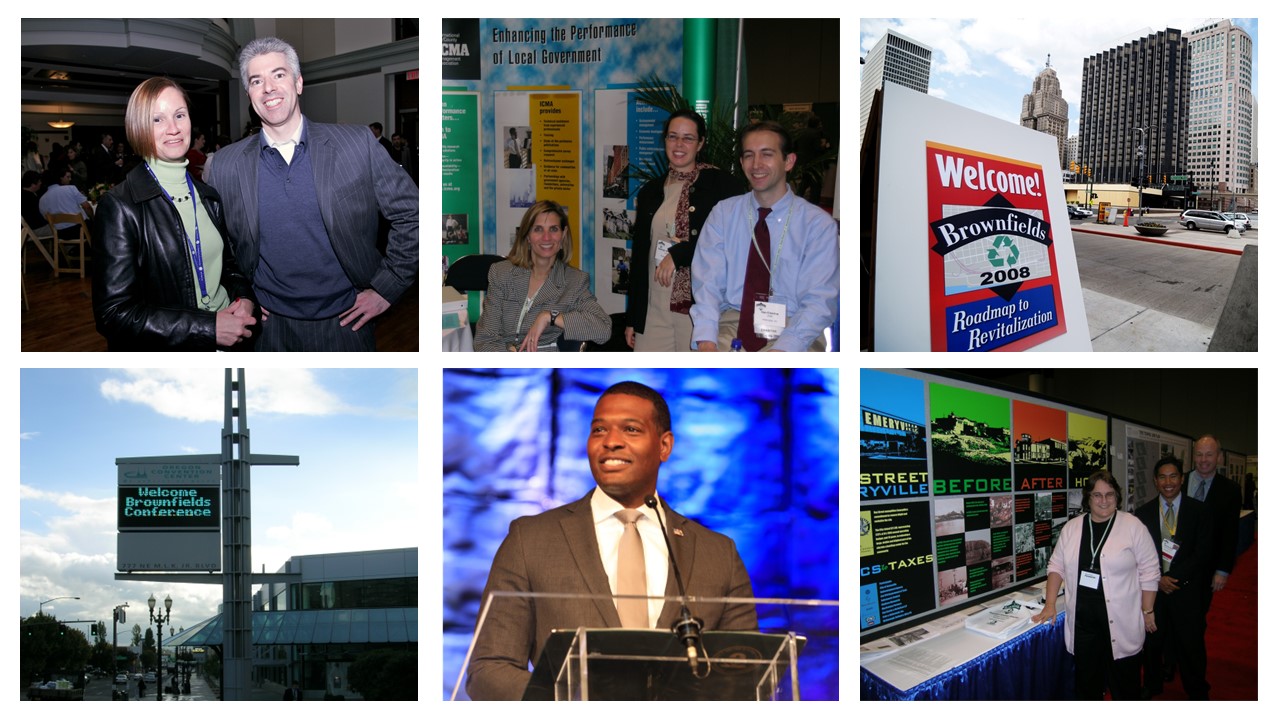
The concept of sustainable communities emerged in the late 1980s, suggesting that decision making consider environmental, social, and economic impacts or the triple bottom line. Since that time, many new and innovative strategies for local sustainability policies, programs, and partnerships have emerged. Many of those ideas have taken hold and become prevailing practices, while others have never gained traction. Of those many approaches that have stuck around, it can be argued that one of the most impactful sets of sustainability concepts are the policies, programs, and partnerships that federal, state, and local governments; the private sector; and community organizations have implemented to return formerly used and potentially contaminated brownfield properties back to productive new uses.
ICMA and Brownfields
Before the term brownfield was coined in the mid-1990s, ICMA was already working on related topics. In the 1970s, the Management Information Service was one of ICMA’s premier modalities for educating members on new challenges. Several issues were focused on managing solid waste facilities and municipal landfills;1 other reports provided ideas for local government to consider when trying to manage urban sprawl and growth.2 The 1973–1974 OPEC oil crisis severely impacted the United States, ushering in an era of inflation and economic challenges. A little-discussed outcome of that crisis was the closure of gas stations across the country. To help local government leaders, ICMA published the Public and Private Utilization of Abandoned Service Stations in 1975.
The onset of the environmental movement in the 1960s and 1970s created a steady stream of federal legislation focused on clean air and water standards, pollution prevention, endangered species, and more. One central piece of legislation, The Comprehensive Environmental Response, Compensation, and Liability Act (or Superfund Law) became law in 1980. Superfund provided a mechanism to clean up uncontrolled or abandoned hazardous commercial, industrial, and transportation sites that were abandoned as the American economy was transitioning. However, like with any new law, there were unintended consequences.
Within a decade, many local jurisdictions were witnessing a reluctance by the private sector to invest in redevelopment due to Superfund restrictions and the fear of becoming a potentially responsible party to massive cleanup liability and costs. By 1990, communities were asking for better definitions of liability and seeking more cooperation among all levels of government, the private sector, and community organizations to identify ways of restarting redevelopment. In the early 1990s, EPA launched the “brownfields initiative,” and later in 1997, the Brownfields National Partnership Action Agenda.
Organizations like ICMA and the U.S. Conference of Mayors were engaged to help EPA conceptualize new strategies for thinking about land use and importantly beneficial redevelopment of formerly used commercial and industrial properties that were only lightly or minimally contaminated.
Throughout the 1990s and into the early 2000s, ICMA was awarded numerous EPA grants to produce training manuals, guidance documents, and online tools, leveraging the growing utility of the internet. A well-regarded resource for many years, ICMA’s Brownfields Redevelopment: A Guidebook for Local Governments and Communities, provided practical programmatic, policy, legal, and regulatory guidance for leaders, managers, and staff in cities and counties. Other workshops, publications, and peer gatherings were developed on related issues, including environmental justice, community engagement, historic preservation as well as special cleanup challenges like underground storage tanks.
The idea of smart growth emerged in the early and mid-1990s as a land use strategy with sustainability undertones and often a focus on infill development, including the reuse of brownfield sites. Again with financial support from EPA, ICMA produced seminal publications from 2000 to 2010 like Getting to Smart Growth, Getting to Smart Growth II, and This is Smart Growth, reports and documents that provided case studies, policy examples, zoning recommendations, and planning strategies for local governments. Putting Smart Growth to Work in Rural Communities became one of ICMA’s most widely downloaded documents at the time of its release in 2010. Widely marketed by ICMA, the focus on small communities and rural places was a welcome addition to the conversations on sustainability, which tend toward the actions of and strategies for larger cities and urban environments. EPA continues to use the document as an outreach tool and content in support of their work.
By the early 2000s, many jurisdictions were beginning to assign responsibilities for “brownfield coordination” to their staff in economic or community development, planning, and public works. Some early adopter cities were hiring staff and creating offices to specifically focus on brownfield cleanup and reuse in their communities. By the time that ICMA conducted its first national survey on local sustainability policies and programs, nearly 22% of the respondents reported that their community had an active program focused on brownfields, vacant property, and reusing abandoned properties.
Twenty Years of National Brownfields Conferences
Since 2003, ICMA has partnered with the U.S. Environmental Protection Agency to lead the National Brownfields Training Conference. ICMA has managed a dozen different conferences in locations around the United States, with each event featuring several thousand attendees, more than 150 educational sessions, and dozens of exhibitors. During this time ICMA has helped more than 45,000 attendees learn about successful strategies for cleaning up and redeveloping brownfield land and properties. Brownfields 2023 takes place in Detroit, Michigan, a city undergoing a generational revitalization with numerous successful redevelopment projects and success stories.
Looking Forward
EPA and others have estimated the number of brownfields at one time to number nearly 450,000. What the true number is nationally is secondary to the fact that most communities with any sort of industrial or commercial history likely have one or more sites in their jurisdiction. Moreover, any time a gas station, dry cleaners, manufacturing site, or even retail and office facilities close or are abandoned, a next generation brownfield is potentially created. Economic cycles are continuously evolving the nature of work and by extension the buildings and the places where that work is conducted. For example, the pandemic has created much more widespread acceptance of hybrid or full-time remote white-collar jobs. With this evolving restructuring of corporate staffing strategies, there is reason to be concerned about a nationwide downsizing of office footprints. Will office buildings and office parks become the next generation of brownfield sites? Similarly, as retail commerce increasingly occurs online, will strip malls and other retail sites become the abandoned properties that communities are more likely to deal with in the future? If so, there is a solid brownfield footing from which to build out strategies, approaches, and ultimately on-the-ground reuse and redevelopment.
After more than three decades of work by stakeholder groups like ICMA and many others, the fear of redeveloping a brownfield site, while not completely mitigated, has at least been substantially reduced. Across the United States today, there exists an ecosystem of firms, agencies, nonprofit organizations, academic researchers, and importantly local government staff and stakeholders that have expertise and experience with the requirements, regulations, and processes for beneficially redeveloping formerly used commercial and industrial properties. Moreover, there are now significant federal grants to help communities. The Bipartisan Infrastructure Law (BIL) has authorized several billion dollars to help local governments and other organizations communities with their brownfield challenges.
As this brief history has demonstrated, ICMA has long supported the work of local cleanup and redevelopment efforts for brownfield properties. That support continues today. In 2021, ICMA became a partner with EPA to help local governments and communities in southeastern U.S. states (see icmatab.org) as part of the Agency’s Technical Assistance for Brownfields Network.3 Similarly, ICMA has continued as the primary partner of EPA in planning the National Brownfields Training Conference, the biennial gathering of all public, private, and community stakeholders focused on revitalization and redevelopment innovations.
The communities led by ICMA members have fostered remarkably transformative redevelopment of brownfield sites across the United States. ICMA is proud to support those efforts with technical assistance and training and to highlight leading practices and examples whenever we can.

TAD MCGALLIARD is director of research and technical assistance at ICMA (tmcgalliard@icma.org).
Endnotes and Resources
1 Managing Solid Waste, Part 1 (November 1973), featured sections on solid waste collection, processing, and resource recovery; Managing Solid Waste, Part 2 (September 1974) covered requirements and best practices for municipal operations of landfills and other solid waste disposal approaches.
2 Local Government Techniques for Managing Growth, May 1974
3 More information on EPA’s TAB program and to find the TAB provider for your community can be found here. More information about ICMA’s TAB work and to request assistance can be found at www.icmatab.org.
New, Reduced Membership Dues
A new, reduced dues rate is available for CAOs/ACAOs, along with additional discounts for those in smaller communities, has been implemented. Learn more and be sure to join or renew today!
